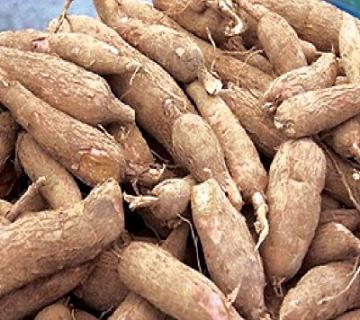
Cassava root (Manihot esculenta)
Synonyms: Jatropha manihot, Jatropha dulcis
Common names: Tapioca, Manioc, Mandioca, Brazil arrowroot, Para arrowroot, Rio arrowroot, Yucca
Local names: Hindi: Shakarkand Manipuri Umangra Marathi: Prochugaali Chine, Pavde-pharin Tamil: Maravallikkilanku, Allvallikizhangu Malayalam: Kollikkilannu, Maraccini, Marakkilannu Telugu: Karrapendalamu Kannada: Kanagale, Mara genasu, Baragaaladagedde Oriya: Kaatokonda Mizo: Pangbal Sanskrit: Tarukandah, Kalpakandah
Cassava is a tall semiwoody perennial shrub or a small tree (4 m height) with large palmately compound leaves. It looks deceptively similar to the castor bean plant. The plant is cultivated widely in the tropics and subtropics, including India and Sri Lanka for its tuberous edible roots, which are 8-30 cm in long and 1-3 cm in diameter. They grow in outward pointing clusters from the base of the stem just below the soil surface. In India, dried cassava roots are sold in the name of tapioca chips, and the meal in the name of tapioca flour.
Availability
In India, availability of cassava is 6.7 million tones (Srinivas and Anantharaman, 2005). Kerela, ranks 1st in cassava production and is largest producer with 50% of area and Tamil Nadu accounts for 32% of area and 9% area is in Andhra Pradesh.
Nutritive value
It is a very good source of energy and rich in carbohydrates (NFE 92%). The crude protein content is 2.4% and TDN content is 67%.
Deleterious factor
Cassava roots contain a glucoside, linamarin, which when acted up on by enzyme liberates prussic acid. The peeled roots contain much less prussic acid than unpeeled roots because most of the prussic acid is in the skin. There are two varieties of cassava: (1) Bitter varieties with roots containing 0.02-0.03% prussic acid. These have to be processed before being used as feed. (2) Sweet varieties with roots containing less than 0.01% prussic acid. These can be used raw for feeding. Most commercial varieties belong to this group. Usually the bitter varieties have longer and thicker roots than the sweet varieties.
Detoxification
The toxic substances can be removed by cooking or by drying slices of the roots for about two weeks (AFRIS, FAO).
Inclusion
In ruminants, it can be used up to 20-25% level in concentrate mixture with economic advantage provided it is mixed with other palatable feed stuffs. Both fresh and dried cassava roots are consumed by ruminants in different forms (sliced, chopped, ground). Dried cassava roots have given satisfactory, results as the principal energy source for dairy cattle (AFRIS, FAO).
